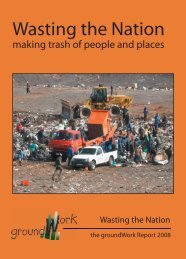La PinTana, ChiLe Prioritizing the recovery of vegetable Waste - GAIA
La PinTana, ChiLe Prioritizing the recovery of vegetable Waste - GAIA
La PinTana, ChiLe Prioritizing the recovery of vegetable Waste - GAIA
Create successful ePaper yourself
Turn your PDF publications into a flip-book with our unique Google optimized e-Paper software.
Figure 1: Municipal Solid <strong>Waste</strong> Characterization in<br />
<strong>La</strong> Pintana (by percentage)<br />
Note: The figure counts all municipal solid waste produced, including <strong>the</strong><br />
materials recovered by <strong>the</strong> informal recyclers.<br />
All over <strong>the</strong> world, municipalities have to manage<br />
increasing amounts <strong>of</strong> waste with scarce resources.<br />
Often, a large portion <strong>of</strong> <strong>the</strong> municipal budget for solid<br />
waste management is spent on waste collection and<br />
disposal, leaving little money for specialized programs.<br />
The situation in <strong>La</strong> Pintana—one <strong>of</strong> <strong>the</strong> communes 2<br />
that constitute <strong>the</strong> heavily-populated Metropolitan<br />
Region <strong>of</strong> Chile—is no exception. Despite belonging<br />
to <strong>the</strong> national capital region, this is one <strong>of</strong> <strong>the</strong> poorest<br />
communities in <strong>the</strong> country, and 80 percent <strong>of</strong> <strong>the</strong><br />
environmental agency’s budget is allocated to <strong>the</strong><br />
collection and disposal <strong>of</strong> solid waste. None<strong>the</strong>less,<br />
while o<strong>the</strong>r governments might see this as an obstacle<br />
to <strong>the</strong> incorporation <strong>of</strong> waste prevention and resource<br />
<strong>recovery</strong> strategies, <strong>La</strong> Pintana focused on making<br />
better use <strong>of</strong> <strong>the</strong> available resources and started a<br />
promising program that is already yielding significant<br />
results.<br />
The head <strong>of</strong> Dirección de Gestión Ambiental<br />
(Environmental Management Agency) <strong>of</strong> <strong>La</strong> Pintana<br />
explained <strong>the</strong> municipality’s decision to take a new<br />
approach to waste management with <strong>the</strong> adage,<br />
“Insanity is doing <strong>the</strong> same thing over and over,<br />
expecting to achieve different results.” Recognizing, as<br />
well, <strong>the</strong> importance <strong>of</strong> continuing that which is working<br />
well, <strong>the</strong> <strong>La</strong> Pintana commune identified all <strong>the</strong> actors<br />
involved in waste management (e.g., businesses,<br />
formal and informal recyclers, citizens, government<br />
bodies) and <strong>the</strong>ir different levels <strong>of</strong> responsibility in<br />
waste generation. The municipality understands that<br />
discarded materials are resources, and as a result,<br />
waste is viewed as an opportunity, not as a problem to<br />
get rid <strong>of</strong>. The municipality also understands that <strong>the</strong><br />
solutions need to be local. The fur<strong>the</strong>r waste travels<br />
from <strong>the</strong> point <strong>of</strong> generation, <strong>the</strong> bigger a problem<br />
it becomes and <strong>the</strong> more likely its management will<br />
be unsustainable. Thus, <strong>the</strong> priority is to manage<br />
resources as close as possible to where <strong>the</strong>y<br />
are generated.<br />
Guided by this vision, an analysis <strong>of</strong> <strong>the</strong> local situation<br />
was carried out. First, a waste audit was conducted,<br />
which showed that <strong>the</strong> solid waste generated<br />
in <strong>La</strong> Pintana is 0.77 kg/person/day. Second, a<br />
characterization <strong>of</strong> waste by source was carried out<br />
(see Figure 1). Finally, a program based on waste<br />
streams (instead <strong>of</strong> source) was developed, guided by<br />
<strong>the</strong> principle that it does not matter if a given waste<br />
stream is produced by households or businesses; <strong>the</strong><br />
treatment depends merely on its characteristics.<br />
Separation and Collection<br />
With this data in hand and <strong>the</strong> system designed, in<br />
December <strong>of</strong> 2005 <strong>the</strong> municipality launched its new<br />
program. Unlike many materials <strong>recovery</strong> strategies<br />
adopted in <strong>La</strong>tin America, this one did not focus on<br />
recycling dry materials, but on recovering <strong>vegetable</strong><br />
waste. This decision was fundamental, since<br />
<strong>vegetable</strong> waste is <strong>the</strong> largest waste stream, <strong>the</strong><br />
one that makes <strong>recovery</strong> <strong>of</strong> recyclables more<br />
Worm beds in <strong>La</strong> Pintana. (photo: DIGA)<br />
Global Alliance for Incinerator Alternatives<br />
<strong>La</strong> Pintana, Chile: <strong>Prioritizing</strong> <strong>the</strong> Recovery <strong>of</strong> Vegetable <strong>Waste</strong> | 2

















